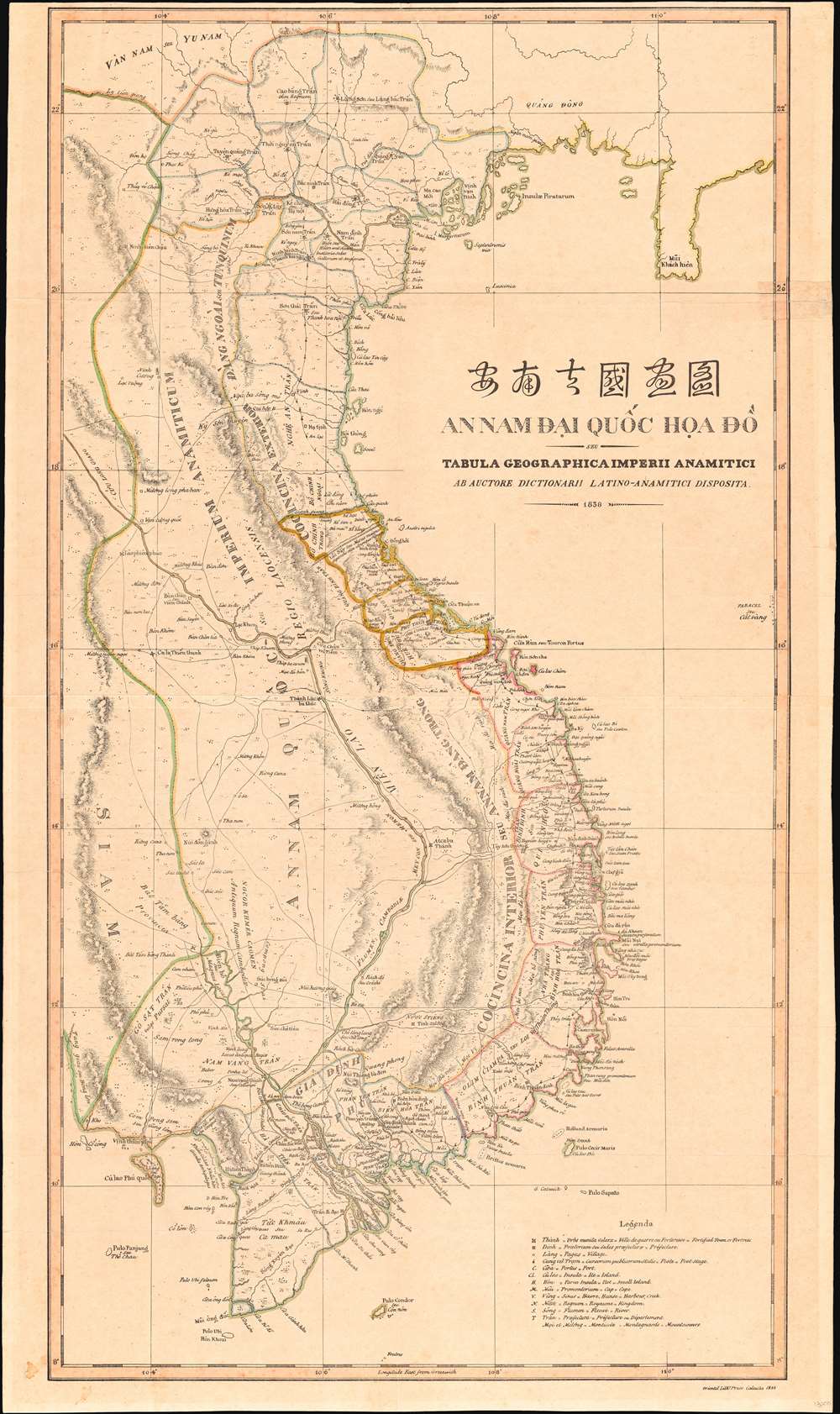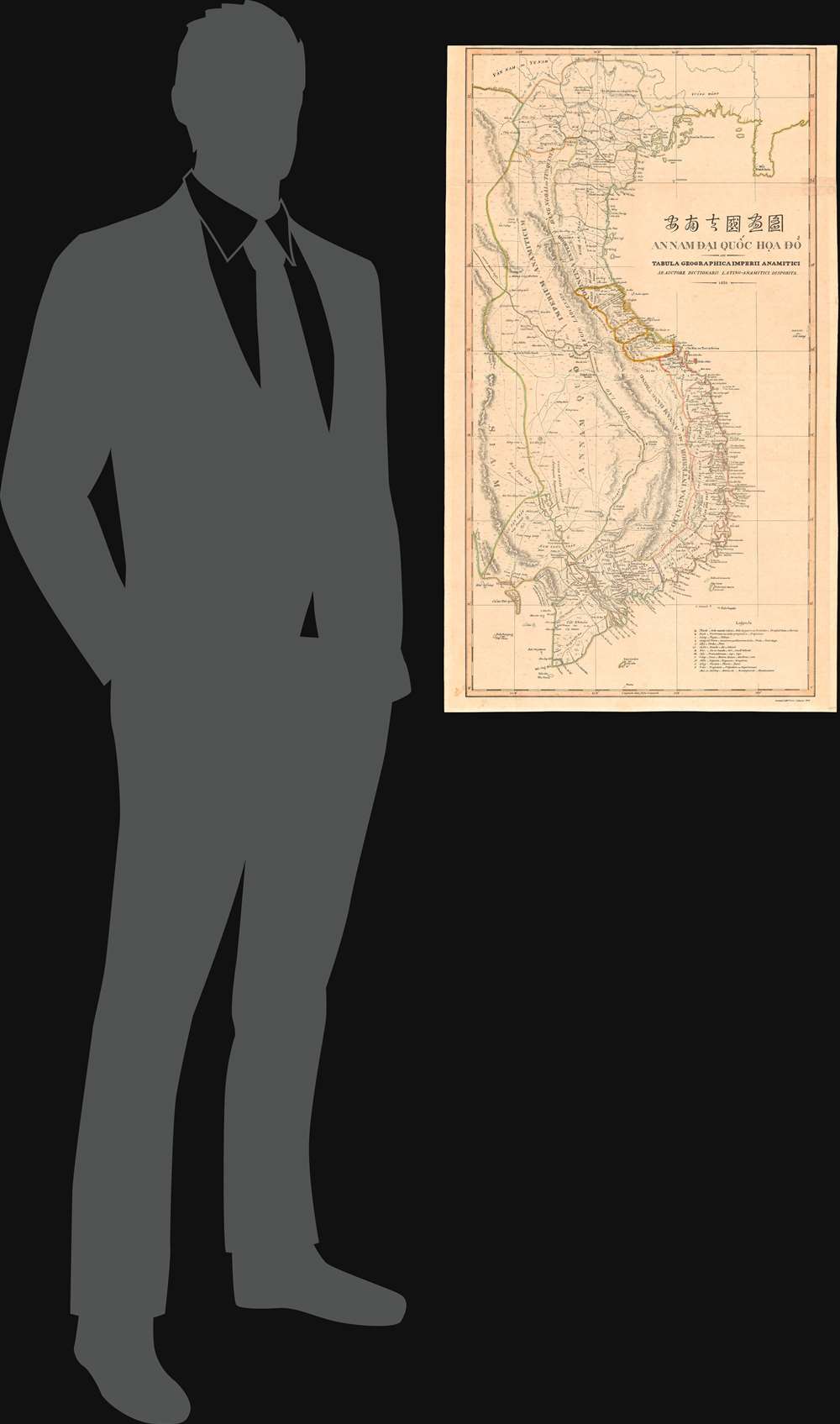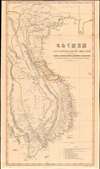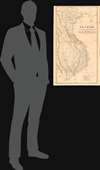Digital Image: 1838 Taberd Map of Vietnam - synthesis of Vietnamese and Western Cartography
Vietnam-taberd-1838_d
Title
1838 (dated) 33.25 x 19.5 in (84.455 x 49.53 cm) 1 : 2100000
Description
FOR THE ORIGINAL ANTIQUE MAP, WITH HISTORICAL ANALYSIS, CLICK HERE.
Digital Map Information
Geographicus maintains an archive of high-resolution rare map scans. We scan our maps at 300 DPI or higher, with newer images being 600 DPI, (either TIFF or JPEG, depending on when the scan was done) which is most cases in suitable for enlargement and printing.
Delivery
Once you purchase our digital scan service, you will receive a download link via email - usually within seconds. Digital orders are delivered as ZIP files, an industry standard file compression protocol that any computer should be able to unpack. Some of our files are very large, and can take some time to download. Most files are saved into your computer's 'Downloads' folder. All delivery is electronic. No physical product is shipped.
Credit and Scope of Use
You can use your digial image any way you want! Our digital images are unrestricted by copyright and can be used, modified, and published freely. The textual description that accompanies the original antique map is not included in the sale of digital images and remains protected by copyright. That said, we put significant care and effort into scanning and editing these maps, and we’d appreciate a credit when possible. Should you wish to credit us, please use the following credit line:
Courtesy of Geographicus Rare Antique Maps (https://www.geographicus.com).
How Large Can I Print?
In general, at 300 DPI, you should at least be able to double the size of the actual image, more so with our 600 DPI images. So, if the original was 10 x 12 inches, you can print at 20 x 24 inches, without quality loss. If your display requirements can accommodate some loss in image quality, you can make it even larger. That being said, no quality of scan will allow you to blow up at 10 x 12 inch map to wall size without significant quality loss. For more information, it is best consult a printer or reprographics specialist.
Refunds
If the high resolution image you ordered is unavailable, we will fully refund your purchase. Otherwise, digital images scans are a service, not a tangible product, and cannot be returned or refunded once the download link is used.
Cartographer S
Jean-Louis Taberd (June 18, 1794 - July 31, 1840) was a French missionary active in Vietnam in the early 19th century. Tabard was born in Saint-Étienne, France, and ordained priest in Lyon in 1817. In 1820, he joined the La Société des Missions Etrangères de Paris, who appointed him to Cochinchina - part of modern-day Vietnam. He became the Victor Apostolic of Cochinchina in 1827, in 1830 Bishop of the titular see of Isauropolis (a defunct bishopric in Turkey), and in 1838 the Vicar Apostolic of Bengal. In 1825, the Emperor of Vietnam, Minh Mạng (1791 - 1841) banned all missionaries. Those that remained, mostly French Catholics, were in constant danger. Between 1833 and 1838, no less than seven were sentenced to death. Tabard fled in the early 1830s to Penang, then Calcutta. There, 1838, he published his famous Latin-Vietnamese dictionary, Dictionarium Anamitico-Latinum. Tabard died in Calcutta. Although Tabard did not return to Vietnam, in the late 19th century the Catholic college Institut Taberd was founded in Saigon by the Brothers of the Christian Schools and, since 1943, educated the Vietnamese elite. More by this mapmaker...
Oriental Lithographic Press (1829/30 - c. 1841) was a publisher and lithographic printer active in early 19th century Calcutta, India. The firm was founded by Jean-Baptiste Athanase Tassin (May 3, 1800 - January 25, 1868). Tassin was born in Aix, France, where he trained as a naturalist. He joined a French government expedition to the East Indies as a naturalist. During this voyaged he became a master draughtsman. His ship wrecked in the Malayan archipelago in the late 1820s, leaving Tassin stranded in Singapore. He somehow worked his way to Calcutta, where, receiving a loan of 10,000 Rupees from Henry Thoby Prinsep, he began a small publishing house specializing in government work. His skill as a draughtsman brought him business as map printer, leading to rich government contracts for such work, his skill often granting him precedence over official government-operated presses. His business lasted until c. 1941, but it is said that he left India around 1839, with a considerable nest-egg of some 16,000 GBP. He was described with praise in the Calcutta Courier (June 27, 1832),
Mr. Tassin is a gentleman of much sterling worth. He is the most successful of all the lithographer of the East, but he owes much to the aid afforded to him by the experience of others. His zeal, and I may say enthusiasm, for lithography, as well as his industry and perseverance, make up for much of the other requisites.Tassin remained in France throughout the 1840s employed as a cartographer with the French Army. The 1848 February Revolution drove him into exile in San Francisco - just in time for the Gold Rush. He published published several maps of San Francisco in the mid-1850s and may have been an over of Sacramento's Adelphi Theater. The Adelphi burned in 1858, at which time Tassin returned to Paris. Ernest de Massey, a fellow Frenchman in San Francisco, recorded meeting Tassin,
Another silhouette ... This one is of Sieur Tassin, Chevalier of the Legion d’Honneur, ex-engineer of geography of the French government, commissioned in the Orient. He seemed to do his work with honesty. He was in haste to leave his business which must have been repugnant to him. Very ingratiating, pleasant and polite, he would have been better suited to a drawing room than a gambling house. He made a fortune and went away. In 1860 I met him on the street of Paris. He was then a “big” Monsieur Tassin. If I had met him in a drawing-room his face would have shown much more embarrassment, as I do not believe he advertised his ability at the green-covered table where the nuggets were easier to gather than they were in the mines.Tassin died in France of unknown causes. For our research on Tassin we are somewhat indebted to Ashley Baynton-Williams. Learn More...




